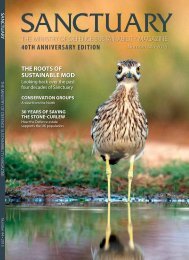SUSTAINABILITY
UBUt5
UBUt5
Create successful ePaper yourself
Turn your PDF publications into a flip-book with our unique Google optimized e-Paper software.
FEATURES<br />
Conserving the bridleway<br />
at Elstead Common<br />
Flooded bridleway in desperate need of repair © Landmarc Support Services<br />
Landmarc Support Services has<br />
worked closely with the Defence<br />
Infrastructure Organisation and Natural<br />
England on a project to restore an old<br />
flooded bridleway and track on Elstead<br />
Common, making it a usable resource<br />
for both military training and the local<br />
community, whilst preserving and<br />
enhancing the protected habitats of a<br />
diverse range of wildlife.<br />
Elstead Common in Surrey, in the South<br />
East Region of the defence training<br />
estate, is an important training feature<br />
for soldiers practising logistics and minor<br />
infantry manoeuvre exercises. It is also<br />
a popular location for walkers, cyclists<br />
and horse riders from the surrounding<br />
villages, and part of a Site of Special<br />
Scientific Interest, a Special Protection<br />
Area and next to a Ramsar wetland on<br />
Thursley National Nature Reserve.<br />
access and access by the emergency<br />
services to respond to heath fires, which<br />
are common in the area.<br />
The solution was to raise the level of the<br />
track and introduce a prominent camber<br />
to enhance drainage. This was achieved<br />
using the old traditional method of<br />
excavating and re-using the existing<br />
green sand from alongside the bridleway<br />
to create holding banks and ditches.<br />
The excavated sand was then<br />
compacted in layers to form a strong<br />
base, raising the bridleway by some<br />
6ft in the worst areas. Rather than just<br />
creating a linear ditch to provide the<br />
drainage solution, the material was<br />
harvested by constructing a series<br />
of linked shallow swales or ponds<br />
alongside the bridleway. These will<br />
slow down the water flow into local<br />
streams and rivers and deliver an<br />
additional structural diversity to the<br />
heathland mosaic that will benefit<br />
wildlife. South facing banks attract<br />
basking reptiles like the sand lizard,<br />
smooth snake and adder as well as<br />
feeding birds such as the dartford<br />
warbler, wood lark and stonechat and<br />
over 20 species of breeding dragonflies<br />
and damselflies. A hibernacula has<br />
also been created from the rotting<br />
wood covered with soil to provide<br />
a safe place for hibernating reptiles,<br />
amphibians and other wildlife.<br />
By adopting old fashioned engineering<br />
methods to manage the water flow,<br />
using natural earth and sods, the<br />
project has delivered a sustainable,<br />
value for money solution with minimal<br />
impact on the environment. The<br />
swales also provide an important<br />
conser vation feature, where local<br />
schools, community groups, Wildlife<br />
Trusts and families can bring children to<br />
safely study the local wildlife.<br />
Robert Hodson<br />
Rural Manager, South East<br />
Landmarc Support Services<br />
A section of the bridleway had become<br />
increasingly prone to flooding over<br />
recent years, with parts more or less<br />
permanently under water. This caused<br />
the area to deteriorate to such an extent<br />
that it was impassable on foot, by horse<br />
or by vehicle, presenting significant<br />
challenges for military training, public<br />
The restored bridleway and track provides year round access for all users © Landmarc Support Services<br />
44<br />
Sanctuary 44 • 2015



